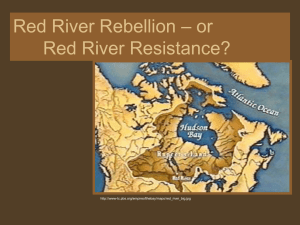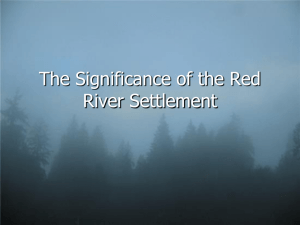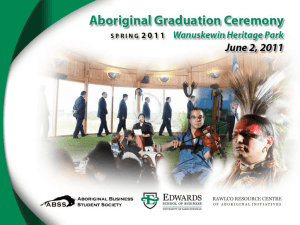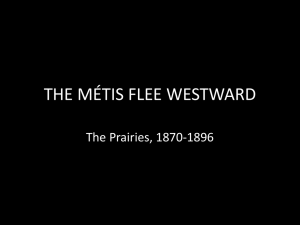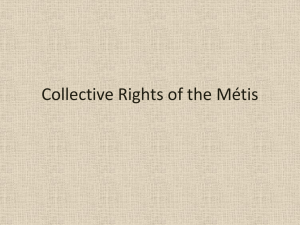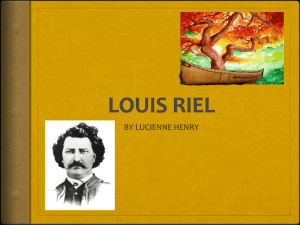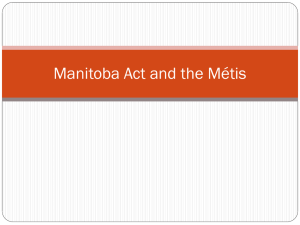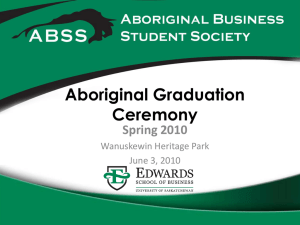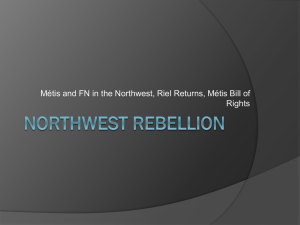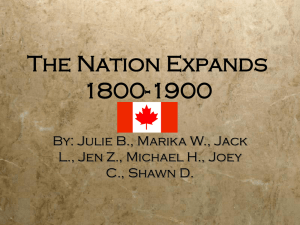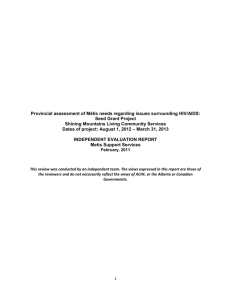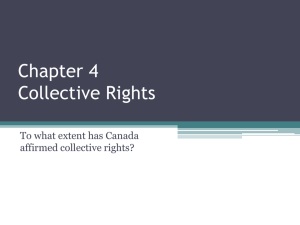Chapter 8 Notes # 2
advertisement
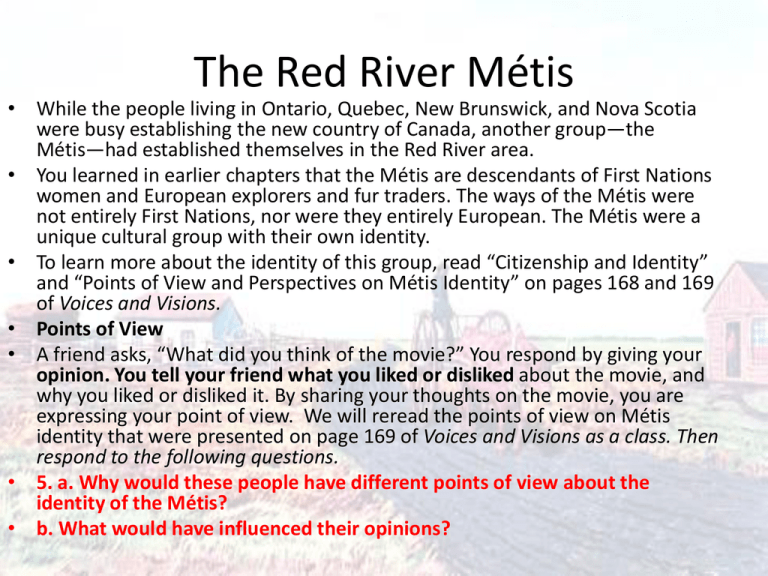
The Red River Métis • While the people living in Ontario, Quebec, New Brunswick, and Nova Scotia were busy establishing the new country of Canada, another group—the Métis—had established themselves in the Red River area. • You learned in earlier chapters that the Métis are descendants of First Nations women and European explorers and fur traders. The ways of the Métis were not entirely First Nations, nor were they entirely European. The Métis were a unique cultural group with their own identity. • To learn more about the identity of this group, read “Citizenship and Identity” and “Points of View and Perspectives on Métis Identity” on pages 168 and 169 of Voices and Visions. • Points of View • A friend asks, “What did you think of the movie?” You respond by giving your opinion. You tell your friend what you liked or disliked about the movie, and why you liked or disliked it. By sharing your thoughts on the movie, you are expressing your point of view. We will reread the points of view on Métis identity that were presented on page 169 of Voices and Visions as a class. Then respond to the following questions. • 5. a. Why would these people have different points of view about the identity of the Métis? • b. What would have influenced their opinions? Learning Outcome • Develop skills of critical thinking and creative thinking • Critically evaluate ideas, information, and positions from multiple perspectives Flash Back Perspective • To increase student involvement and engagement I have increased the amount of interactive student activities within our lessons. • http://www.youtube.com/watch?v=4BPxF1mLYF M • Flashback perspectives are one of these. • For a flashback perspective the teacher will turn off the lights. A student will be flashed with the back in history light this student will take the role of an individual in history. Flash back Perspectives • “They one and all look upon themselves as members of an independent tribe of natives, entitled to a property in the soil, to a flag of their own, and protection from the government.” • William McGillivary, fur trader, 1818 Lord Dufferin, Governor General of Canada • “They are the ambassadors between East and West.” Joel Anderson, 10 year old Métis from Manitoba, 1982 • “We are Indian, we are white… We are rejected by them both Although we are lost between… We continue to grow as a Métis”.” Louis Riel, Metis leader, 1869 • “We may be a small community….. But we are men, free and spirited men, and we will not allow even the Dominion of Canada to trample our rights.” Christi Belcourt, Métis artist from Lac Sainte-Anne, Alberta, 2002 • “Identity is multi layered. While I paint flowers to express and celebrate my Métisness… I also have other reasons that don’t necessarily have anything to do with a broader sense of myself as a member of the human race desiring to contribute something positive to the world.” Questions re-examined • 5. a. Why would these people have different points of view about the identity of the Métis? • b. What would have influenced their opinions? A Métis Identity Emerges • By the 1860s the Red River area in present-day Manitoba was the most populated area in Rupert’s Land. Turn to Voices and Visions and read “The Demographics of Red River” on pages 171 and 172 to find out who the people of Red River were. Be sure to read the Focus question before you begin. • What exactly are demographics? • Demographics refer to data about the population of a particular place. It might be data about the ages of the people of a particular area, or it could be data about how many males or females make up a certain population. The word itself comes from the Greek demos, which means people. The information collected by demographers—population experts—shows population changes such as movement of people. Businesses and governments use demographics to make plans for the future. • Although the Métis were the majority in the Red River region, people from many different groups lived there. In other words, the area was quite multicultural. • Think about the cultural demographics in your classroom, school, or community. What cultural groups make up the demographics? Is one group larger, or are the populations of the groups about the same size? Learning Outcome • Critically assess the role, contributions, and influence of the Red River Métis on the development of Canada. Visual Learners • Before we critically assess the impact of the Métis. We will explore where they settled and where they migrated to in a map assignment. Map Activity • Using the map handout, the second map handout I will give you now and the information from pgs. 171-175 you will be completing a map assignment. • You are going to copy the map on pg. 171 on to two separate maps. • One will be based on settlements before 1870 • The second map will be based on Metis settlements after 1870. • You will include a legend on each map with specifics labelled that are included on the outline I am providing you with. Map Activity/Learning Outcome • For this activity you will be creating two separate maps. The purpose of this assignment is…. Or more importantly the learning out come is: • construct and interpret maps to broaden understanding of issues, places, and people of Canada • Interpret historical maps to broaden understanding of historical events. Map # 1 Label • • • • • Métis settlements, before 1870 Métis movements, 1870-1880 Interlake Region, traditional Métis territory Present provincial border Present international border Map # 1 Métis Settlements • • • • • • • Red River (Winnipeg) Grand Maris Grand Rapids Oak point St. Laurant Lac la Biche Fish Lake Map # 2 Label • • • • • • • • Métis Settlements after 1870 Métis movements, 1870-1880 Interlake Region, traditional Métis territory Lac Ste. Anne St. Albert Trail Métis Creek des Métis Cypress Hill • • • • • • • • • • • Duck Lake St. Louis St. Laurent Batoche Cumberland House Prince Albert Turtle Mountain Willowbunch Wood Mountain Cochin Battleford Read pgs. 174-175 • What important features made the Red River area an ideal place to settle? Important geographic features • The open land • The abundant resources • the proximity to the river for transportation and fishing • Fertile soil for farming Other important features • There were also a huge herds of buffalo that roamed the plains • An abundance of wildlife to support the fur trade. • The buffalo hunt and fur trade were two major parts of the Métis economy and way of life. Debate/Class Discussion • As I stated earlier I have reshaped our lessons to increase student involvement. • Debate/Class Discussion is another way we will do this. When this heading comes up we will transform the class in an open forum where students can discuss issues. • http://www.youtube.com/watch?v=e8FgDmo _9sY • We MUST TRANSFORM quietly….. Learning Outcome • Demonstrate skills of oral written, and visual literacy • Communicate information in a clear, persuasive, and engaging manner, through written and oral means. Debate/Class Discussion Question • Why is it important for governments to listen to their citizens and respect their rights? Examples • American revolution • Rebellions of 1837 • Both of these events demonstrated how a lack of respect can lead to frustration , alienation, a lack of support, the desire to separate, resistance and rebellion. • http://www.youtube.com/watch?v=Y3oFDUB uRoQ Should the teachers listen to their students demands??!! • Can students rebel? • http://www.youtube.com/watch?v=cfC3CEdF 1Xg Important terminology • Resistance and Rebellion how are they different? • Copy these terms into your key terms chart • Resistance: is an attempt to withstand government actions • Rebellion: is an armed uprising meant to overthrow the government. Political Aspect • There are also political connotations to the terms. • Connotations: an idea that is implied or suggested • For example the Métis would not have considered themselves under control the control of the Canadian government, and therefore could not technically rebel. Instead as an independent people, they resisted the government’s encroachment.
